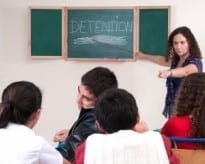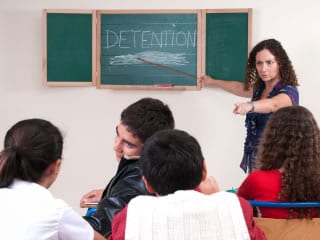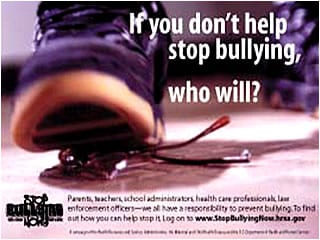How Teachers Should Respond to School Bullying
Setting the stage for responding to bullying.
How to Respond to Bullying…..
First, it is important to acknowledge that students rarely bully victims in front of an adult. The chance of a teacher observing bullying in school is limited. Furthermore, research indicates that only 56% of students report that they have personally observed bullying at school.
Therefore, since it is unlikely you will observe a school bullying incident first hand, and because so few bullying incidents are reported by students, it is a given fact that children are being bullied at school.
The best approach to prevent bullying is to implement a school-wide program, with administrators, parents, staff, students, and community all working together toward the same goal, a great school where students feel safe to learn.
Prior to implementing a schoolwide push, the staff should evaluate the current bullying situation and identify any “hot spots” for bullying at school. Typical hotspots are the lunchroom, restrooms, and the playground. Evaluating the current situation can be accomplished through student interviews, an anonymous reporting box, or staff, student and parent surveys, etc.
The Center for Disease Control (CDC) has published a free set of assessment tools for measuring bullying and victimization, as well as perpetrator and bystander experiences.
Next, the staff should meet to establish agreed upon consequences for bullying offenders. A set plan of action makes on-the-spot intervention more likely and will allow consistency in discipline. A progressive discipline approach might include a warning, bullying report filed with the office, note home to parents, loss of a privilege, detention, etc. Once a discipline system for bullying offenders has been developed, the next step is to develop or adopt your District Policy on Bullying.
Share the policy with students and staff and discuss the shared responsibility for keeping everyone safe at school. Ask students to report bullying.
Bullying prevention is best handled by being proactive and, as in the case of any good school wide discipline plan, with for thought and planning.
Teaching students the definition of bullying is important so that bullying incidents are reported.
Teaching students the definition of bullying is important so that bullying incidents are reported.
A Direct response to an observed bullying incident:
1. Just as in the case of overall student discipline, confront student/s you observe in the action of bullying in a fair and firm manner. Taking immediate action is critical because it sends a clear message that it will not be tolerated. Additionally, research has indicated that when teachers or adults ignore bullying, students interpret it as being “O.K.” for students to behave this way. The message is, “When in Doubt, Take Action.”
2. Begin by relating the incident that you observed or repeating the words that were exchanged. Know that most bullies will respond with “I was only playing around,” or “It was nothing.” A consistent message of high expectations for behavior should be emphasized at every opportunity. Let students know that “we don’t treat people like that here,” which indicates that everyone has the responsibility to see that it stops.
3. After immediately approaching a bully and clarifying what you observed, immediately impose a consequence and reiterate the classroom expectations regarding treating others with respect and kindness. Refrain from asking bully to apologize or discuss the situation with the victim at that time and focus only on the bully who may try to pull the victim into the discussion.
4. If the bully’s behavior does not improve, a bullying report to document subsequent incidents and actions taken should be recorded and shared with the bully’s parents. Asking the parents to come to school for a meeting will emphasize the seriousness of the behavior to parents and allows the school to ask for parent support in curbing the bullying behavior. It is recommended that you confront a bully in private, if possible. Or take immediate action and impose a consequence and move on with other activities, which let the student know you will be spending more time on the issue in private later that day. Remember, bullies like an audience and discipline in front of peers may give the bully the opportunity to be disrespectful and defiant. Conduct all meetings in a business like and factual manner.
5. Consider recruiting “peer volunteers” to support and assist the victim. Although peers may not confront the bully, their support for the victim in encouraging him/her to walk away or report bullying helps the victim feel supported and prevents further isolation.
6. Classroom lessons on pro-social behaviors and activities may prove useful.
7. It goes without saying, a system of monitoring the bully’s behavior and documenting progress to improvement and counseling when necessary should be considered with parents. 8. Check regularly with victims and check to insure that bullying is not continuing. Take appropriate action as necessary.
What Doesn’t Work
It is important to point out what does not work in bullying prevention, as many times they may sound good but in fact are not effective.
Zero Tolerance Policies
A strict enforcement of zero tolerance policies may actually result in less reporting of bullying incidents. If for example, a child is involved in a bullying incident and the incident was a single occurrence, expulsion is not only unnecessary, it may be an inappropriate reaction. Please know that while parents of the victim typically will ask and want to know what discipline has been imposed on the bully, most state child privacy laws prevent releasing this type of information.
Conflict Resolution Policies
Since there is a power differential between the bully and the victim, mediation is not a good alternative and may in fact upset the victim further. Deal with each bullying incident in isolation. When bullying incidents are dealt with in isolation teacher by teacher, they have little effect as compared to a school wide approach to the problem. In conclusion, what happens prior to observing a bullying incident is far more important than responding to an incident.
A school wide focus on the social environment of the school is the key to reducing bullying. If a policy is in place, if the staff is united in confronting the problem, if parents are included in the equation and if an assessment of bullying incidents is in place, then the school’s reaction to a bullying incident will be consistent and measured. An on-going approach includes some class time spent in teaching students pro-social lessons and talking with students about bullying prevention. Anti-bullying themes and messages should be a regular part of a child’s school experience. Finally, realize that there is no end to eliminating bullying, rather bullying prevention programs requires an ongoing monitoring and intervening each and every time an incident o









